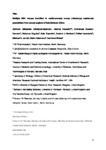Multiple DNA viruses identified in multimammate mouse (Mastomys natalensis) populations from across regions of sub-Saharan Africa
| dc.contributor.author | Calvignac-Spencer, S | |
| dc.contributor.author | Kouadio, L | |
| dc.contributor.author | Couacy-Hymann, E | |
| dc.contributor.author | Sogoba, N | |
| dc.contributor.author | Rosenke, K | |
| dc.contributor.author | Davison, AJ | |
| dc.contributor.author | Leendertz, F | |
| dc.contributor.author | Jarvis, Michael A | |
| dc.contributor.author | Feldmann, H | |
| dc.contributor.author | Ehlers, B | |
| dc.date.accessioned | 2020-09-24T15:11:11Z | |
| dc.date.issued | 2020-10 | |
| dc.identifier.issn | 0304-8608 | |
| dc.identifier.issn | 1432-8798 | |
| dc.identifier.uri | http://hdl.handle.net/10026.1/16422 | |
| dc.description.abstract |
<jats:title>Abstract</jats:title> <jats:p>The multimammate mouse (<jats:italic>Mastomys natalensis; M. natalensis</jats:italic>) serves as the main reservoir for the zoonotic arenavirus Lassa virus (LASV), and this has led to considerable investigation into the distribution of LASV and other related arenaviruses in this host species. In contrast to the situation with arenaviruses, the presence of other viruses in <jats:italic>M. natalensis</jats:italic> remains largely unexplored. In this study, herpesviruses and polyomaviruses were identified and partially characterized by PCR methods, sequencing, and phylogenetic analysis. In tissues sampled from <jats:italic>M. natalensis</jats:italic> populations in Côte d<jats:italic>'</jats:italic>Ivoire and Mali, six new DNA viruses (four betaherpesviruses, one gammaherpesvirus and one polyomavirus) were identified. Phylogenetic analysis based on glycoprotein B amino acid sequences showed that the herpesviruses clustered with cytomegaloviruses and rhadinoviruses of multiple rodent species. The complete circular genome of the newly identified polyomavirus was amplified by PCR. Amino acid sequence analysis of the large T antigen or VP1 showed that this virus clustered with a known polyomavirus from a house mouse (species <jats:italic>Mus musculus polyomavirus 1</jats:italic>). These two polyomaviruses form a clade with other rodent polyomaviruses, and the newly identified virus represents the third known polyomavirus of <jats:italic>M. natalensis</jats:italic>. This study represents the first identification of herpesviruses and the discovery of a novel polyomavirus in <jats:italic>M. natalensis</jats:italic>. In contrast to arenaviruses, we anticipate that these newly identified viruses represent a low zoonotic risk due to the normally highly restricted specificity of members of these two DNA virus families to their individual mammalian host species.</jats:p> | |
| dc.format.extent | 2291-2299 | |
| dc.format.medium | Print-Electronic | |
| dc.language | en | |
| dc.language.iso | en | |
| dc.publisher | Springer (part of Springer Nature) | |
| dc.rights | Attribution-NonCommercial-NoDerivatives 4.0 International | |
| dc.rights | Attribution-NonCommercial-NoDerivatives 4.0 International | |
| dc.rights | Attribution-NonCommercial-NoDerivatives 4.0 International | |
| dc.rights | Attribution-NonCommercial-NoDerivatives 4.0 International | |
| dc.rights.uri | http://creativecommons.org/licenses/by-nc-nd/4.0/ | |
| dc.rights.uri | http://creativecommons.org/licenses/by-nc-nd/4.0/ | |
| dc.rights.uri | http://creativecommons.org/licenses/by-nc-nd/4.0/ | |
| dc.rights.uri | http://creativecommons.org/licenses/by-nc-nd/4.0/ | |
| dc.subject | Africa South of the Sahara | |
| dc.subject | Animals | |
| dc.subject | Antigens, Viral, Tumor | |
| dc.subject | Capsid Proteins | |
| dc.subject | Disease Reservoirs | |
| dc.subject | Genome, Viral | |
| dc.subject | Herpesviridae | |
| dc.subject | Herpesviridae Infections | |
| dc.subject | Host Specificity | |
| dc.subject | Molecular Typing | |
| dc.subject | Murinae | |
| dc.subject | Phylogeny | |
| dc.subject | Polyomavirus | |
| dc.subject | Polyomavirus Infections | |
| dc.subject | Rodent Diseases | |
| dc.subject | Viral Envelope Proteins | |
| dc.title | Multiple DNA viruses identified in multimammate mouse (Mastomys natalensis) populations from across regions of sub-Saharan Africa | |
| dc.type | journal-article | |
| dc.type | Journal Article | |
| plymouth.author-url | https://www.webofscience.com/api/gateway?GWVersion=2&SrcApp=PARTNER_APP&SrcAuth=LinksAMR&KeyUT=WOS:000555711700001&DestLinkType=FullRecord&DestApp=ALL_WOS&UsrCustomerID=11bb513d99f797142bcfeffcc58ea008 | |
| plymouth.issue | 10 | |
| plymouth.volume | 165 | |
| plymouth.publication-status | Published | |
| plymouth.journal | Archives of Virology | |
| dc.identifier.doi | 10.1007/s00705-020-04738-9 | |
| plymouth.organisational-group | /Plymouth | |
| plymouth.organisational-group | /Plymouth/Faculty of Health | |
| plymouth.organisational-group | /Plymouth/Faculty of Health/School of Biomedical Sciences | |
| plymouth.organisational-group | /Plymouth/REF 2021 Researchers by UoA | |
| plymouth.organisational-group | /Plymouth/REF 2021 Researchers by UoA/UoA01 Clinical Medicine | |
| plymouth.organisational-group | /Plymouth/Research Groups | |
| plymouth.organisational-group | /Plymouth/Research Groups/Institute of Translational and Stratified Medicine (ITSMED) | |
| plymouth.organisational-group | /Plymouth/Research Groups/Institute of Translational and Stratified Medicine (ITSMED)/CBR | |
| plymouth.organisational-group | /Plymouth/Users by role | |
| plymouth.organisational-group | /Plymouth/Users by role/Academics | |
| dc.publisher.place | Austria | |
| dcterms.dateAccepted | 2020-06-17 | |
| dc.rights.embargodate | 2020-9-26 | |
| dc.identifier.eissn | 1432-8798 | |
| dc.rights.embargoperiod | Not known | |
| rioxxterms.versionofrecord | 10.1007/s00705-020-04738-9 | |
| rioxxterms.licenseref.uri | http://creativecommons.org/licenses/by-nc-nd/4.0/ | |
| rioxxterms.licenseref.startdate | 2020-10 | |
| rioxxterms.type | Journal Article/Review |



